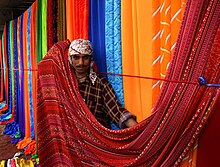What does Textiles mean?
Definitions for Textiles
tex·tiles
This dictionary definitions page includes all the possible meanings, example usage and translations of the word Textiles.
Did you actually mean tasteless or tactless?
Wikipedia
textiles
Textile is an umbrella term that includes various fiber-based materials, including fibers, yarns, filaments, threads, different fabric types, etc. At first, the word "textiles" only referred to woven fabrics. However, weaving is not the only manufacturing method, and many other methods were later developed to form textile structures based on their intended use. Knitting and non-woven are other popular types of fabric manufacturing. In the contemporary world, textiles satisfy the material needs for versatile applications, from simple daily clothing to bulletproof jackets, spacesuits, and doctor's gowns.Textiles are divided into two groups: Domestic purposes [consumer textiles] and technical textiles. In consumer textiles, aesthetics and comfort are the most important factors, but in technical textiles, functional properties are the priority.Geotextiles, industrial textiles, medical textiles, and many other areas are examples of technical textiles, whereas clothing and furnishings are examples of consumer textiles. Each component of a textile product, including fiber, yarn, fabric, processing, and finishing, affects the final product. Components may vary among various textile products as they are selected based on their fitness for purpose.Fiber is the smallest component of a fabric; fibers are typically spun into yarn, and yarns are used to manufacture fabrics. Fiber has a hair-like appearance and a higher length-to-width ratio. The sources of fibers may be natural, synthetic, or both. The techniques of felting and bonding directly transform fibers into fabric. In other cases, yarns are manipulated with different fabric manufacturing systems to produce various fabric constructions. The fibers are twisted or laid out to make a long, continuous strand of yarn. Yarns are then used to make different kinds of fabric by weaving, knitting, crocheting, knotting, tatting, or braiding. After manufacturing, textile materials are processed and finished to add value, such as aesthetics, physical characteristics, and increased usefulness. The manufacturing of textiles is the oldest industrial art. Dyeing, printing, and embroidery are all different decorative arts applied to textile materials.
Editors Contribution
textiles
Plural form of the word textile.
The textiles were very beautiful.
Submitted by MaryC on March 2, 2020
Numerology
Chaldean Numerology
The numerical value of Textiles in Chaldean Numerology is: 3
Pythagorean Numerology
The numerical value of Textiles in Pythagorean Numerology is: 6
Examples of Textiles in a Sentence
I did all my sets, i went into fabric stores and spent hours looking at textiles and thinking about how light is going to reflect on them.
The minimum wage hike could lead to increases in salaries for workers on higher pay scales. If companies don't take additional measures, costs will go up and shrink margins, companies could decrease employment or cut bonuses. Export sectors such as textiles could shift their production to other countries to avoid losing their competitive advantage.
Contract work for textiles has been growing exponentially because of the growing popularity of readymade garments and fast fashion, even in India, many leading global brands are outsourcing to homeworkers, even if they are unaware of it. Homeworkers are the most vulnerable in the chain, yet they bear a lot of risks because the economic compulsion is so strong.
The industrialization of textiles became affordable to a much broader segment of society, retailers of mourning goods developed on a much grander scale and target middle-class consumers taking advantage of these readily available textiles.
I have a friend—an architect—who came to my house and was looking at some of my electric irons. I pointed out how each of the cords were textiles of all different colors. She thought that was an interesting design detail and told her sons about it. One of them responded, ‘You mean somebody designed that?’ and she said, ‘Well, it didn’t fall out of the sky.”
Popularity rank by frequency of use
References
Translations for Textiles
From our Multilingual Translation Dictionary
Get even more translations for Textiles »
Translation
Find a translation for the Textiles definition in other languages:
Select another language:
- - Select -
- 简体中文 (Chinese - Simplified)
- 繁體中文 (Chinese - Traditional)
- Español (Spanish)
- Esperanto (Esperanto)
- 日本語 (Japanese)
- Português (Portuguese)
- Deutsch (German)
- العربية (Arabic)
- Français (French)
- Русский (Russian)
- ಕನ್ನಡ (Kannada)
- 한국어 (Korean)
- עברית (Hebrew)
- Gaeilge (Irish)
- Українська (Ukrainian)
- اردو (Urdu)
- Magyar (Hungarian)
- मानक हिन्दी (Hindi)
- Indonesia (Indonesian)
- Italiano (Italian)
- தமிழ் (Tamil)
- Türkçe (Turkish)
- తెలుగు (Telugu)
- ภาษาไทย (Thai)
- Tiếng Việt (Vietnamese)
- Čeština (Czech)
- Polski (Polish)
- Bahasa Indonesia (Indonesian)
- Românește (Romanian)
- Nederlands (Dutch)
- Ελληνικά (Greek)
- Latinum (Latin)
- Svenska (Swedish)
- Dansk (Danish)
- Suomi (Finnish)
- فارسی (Persian)
- ייִדיש (Yiddish)
- հայերեն (Armenian)
- Norsk (Norwegian)
- English (English)
Word of the Day
Would you like us to send you a FREE new word definition delivered to your inbox daily?
Citation
Use the citation below to add this definition to your bibliography:
Style:MLAChicagoAPA
"Textiles." Definitions.net. STANDS4 LLC, 2025. Web. 23 Feb. 2025. <https://www.definitions.net/definition/Textiles>.







Discuss these Textiles definitions with the community:
Report Comment
We're doing our best to make sure our content is useful, accurate and safe.
If by any chance you spot an inappropriate comment while navigating through our website please use this form to let us know, and we'll take care of it shortly.
Attachment
You need to be logged in to favorite.
Log In